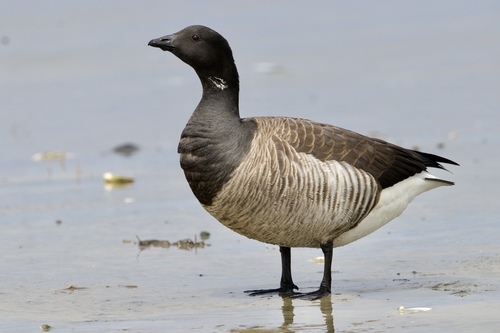
Brant
The Brant, *Branta bernicla*, is a small, dark goose with a distinctive appearance and fascinating life history. It is a truly circumpolar species, breeding in the high Arctic tundra and wintering along coastlines further south. Brant are highly specialized for their environment, playing a crucial role in coastal ecosystems. They are known for their long-distance migrations and strong dependence on specific food sources, particularly eelgrass and sea lettuce. While not holding major cultural significance in many regions, their annual arrival is a celebrated event for birdwatchers along their migration routes.
55-66 cm
Length
106-121 cm
Wingspan
Least Concern
Conservation Status
Distribution
Brant breed in the high Arctic regions of North America, Europe, and Asia. Their migration routes are extensive, leading them to wintering grounds along the coasts of North America (both Pacific and Atlantic), Western Europe, and East Asia (primarily China, Korea, and Japan). They exhibit a strong preference for coastal habitats.
Lifespan
Up to 28 years has been recorded in the wild, but typical lifespan is likely shorter.
Brant's Habitat
Habitat Types
Coastal salt marshes, Estuaries, Tidal mudflats, Lagoons, Arctic Tundra (during breeding season)
Climate Zones
Arctic, Subarctic, Temperate
Adaptations
Brant have developed several adaptations to their coastal and Arctic environments. They possess salt glands, allowing them to excrete excess salt from the seawater they ingest. Their dense down feathers provide excellent insulation against the cold Arctic winds and icy waters.
Variations
There are three generally recognized subspecies: the Dark-bellied Brant (*B. b. bernicla*), the Pale-bellied Brant (*B. b. hrota*), and the Black Brant (*B. b. nigricans*). These subspecies differ primarily in their plumage coloration and geographic distribution.
Appearance
Breeding Plumage
Plumage is relatively consistent throughout the year, with minimal differences between breeding and non-breeding seasons.
Seasonal Feather Changes
No significant seasonal change.
Sex Based Plumage Differences
Sexes are similar in plumage.
Notable Features
Small white neck patches (variable in size and shape), Dark brown or black head, neck, and breast, Relatively short neck compared to other geese
Diet and Feeding
Primary Foods
Eelgrass (Zostera marina), Sea lettuce (Ulva lactuca), Various coastal grasses and sedges, Algae, Small invertebrates (occasionally)
Foraging Behavior
Brant primarily graze on vegetation in shallow water or on exposed mudflats. They often feed in large flocks, submerging their heads and necks to reach submerged plants. They can also up-end, like dabbling ducks, to reach deeper vegetation.
Specializations
Their strong bills are well-suited for tearing and consuming tough coastal plants. Their digestive systems are adapted to efficiently process a diet high in cellulose.
Seasonal Diet Variations
During the breeding season, they consume more terrestrial vegetation, including grasses, mosses, and lichens. Their winter diet is heavily reliant on eelgrass and sea lettuce, where available.
Behavior
Social Structure
Brant are highly social, forming large flocks during migration and wintering. They are less gregarious during the breeding season, but often nest in loose colonies.
Communication
A soft, throaty 'cronk' call, Head-bobbing and wing-flapping displays, Various vocalizations during courtship and territorial defense
Migration
Brant undertake long-distance migrations, traveling thousands of kilometers between their breeding and wintering grounds. They often fly in large, V-shaped formations. Navigation is thought to be a combination of learned routes, visual landmarks, and possibly the Earth's magnetic field.
Territorial or Group Behaviors
During the breeding season, males defend a small territory around the nest. Outside of breeding, they are highly social and form large flocks for feeding and roosting.
Conservation
Threats
Habitat loss and degradation (especially loss of eelgrass beds), Climate change (affecting breeding grounds and food availability), Disturbance from human activities (e.g., boating, hunting), Oil spills and other pollution, Predation (especially of eggs and young by Arctic foxes, gulls, and jaegers)
Protection Programs
Migratory Bird Treaty Act (in North America), Various international agreements protecting migratory birds, Habitat restoration projects (e.g., eelgrass replanting), Monitoring of populations and breeding success
Local National Laws
Protected under various national and international laws, including the Migratory Bird Treaty Act in the US and Canada, and similar legislation in other countries.
Population Trend
Stable overall, but some populations show declines.
Population Estimates
Global population estimated at around 500,000-700,000 individuals.
Interesting Facts
Brant are almost entirely dependent on coastal habitats.
Unlike many other geese, they rarely venture far inland, even during migration.
They have a strong preference for eelgrass.
Declines in eelgrass populations have been linked to declines in Brant numbers in some areas.
They can fly at speeds of up to 70 km/h (43 mph).
This allows them to cover vast distances during their migrations.
The oldest recorded Brant was over 28 years old.
Banding studies help track their movements and lifespan.
Faqs about Brant
What is the difference between a Brant and a Canada Goose?
Brant are smaller than Canada Geese, with a darker overall coloration and a small white neck patch instead of a large white 'chinstrap'.
Where can I see Brant?
Brant can be seen along coastlines during migration and winter. Look for them in estuaries, salt marshes, and tidal flats.
Are Brant hunted?
Brant are hunted in some areas, subject to regulations and bag limits. Hunting seasons are carefully managed to ensure sustainable populations.
Do brant mate for life?
Brant are believed to be mostly monogamous and form long-term pair bonds, often staying together for many years. However, if one partner dies, the surviving bird may find a new mate.
Copyright @ Nature Style Limited. All Rights Reserved.
 English
English